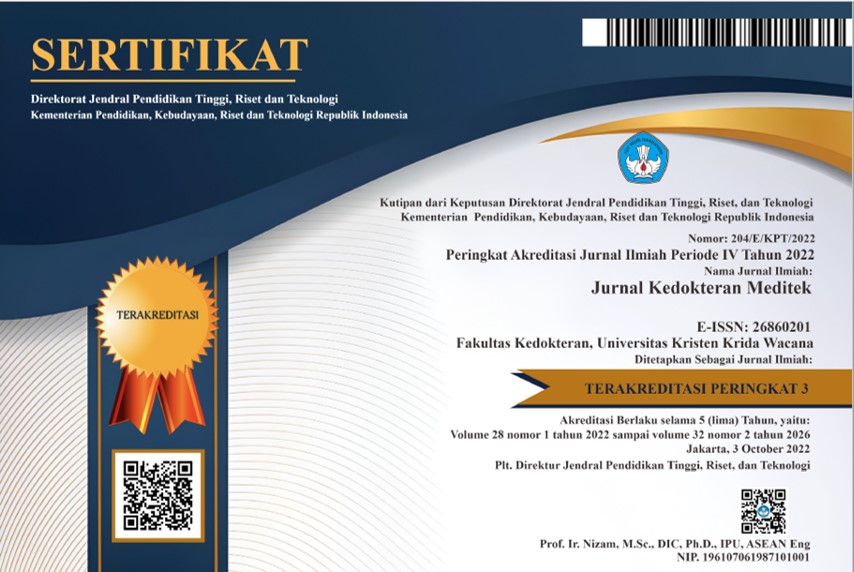The Kemampuan Ekstrak Etanol Batang Brotowali (Tinospora crispa L.) Sebagai Antifungi Terhadap Candida tropicalis
DOI:
https://doi.org/10.36452/jkdoktmeditek.v29i2.2622Keywords:
Antifungi, brotowali, Candida tropicalis, konsentrasi hambat minimum, Tinospora crispa LAbstract
Candida tropicalis adalah salah satu spesies non-Candida albicans yang paling umum diisolasi dari berbagai jenis kandidiasis dan infeksi nosokomial. Spesies ini adalah yang paling virulen kedua di antara spesies Candida. Meluasnya penggunaan antijamur sebagai profilaksis menjadi penyebab utama resistensi antifungi. Batang brotowali (Tinospora crispa L.) digunakan sebagai obat herbal di Asia, termasuk Indonesia. Terdapat lebih dari 65 senyawa fitokimia, dan beberapa di antaranya diidentifikasi sebagai agen antijamur potensial, seperti kelompok flavon, alkaloid, berberin, saponin, dan tanin. Penelitian ini bertujuan untuk mengetahui aktivitas antijamur batang brotowali dan menentukan konsentrasi hambat minimum. Batang brotowali terstandar diolah dengan metode maserasi untuk menghasilkan ekstrak etanol. Kerentanan C. tropicalis terhadap ekstrak etanol batang brotowali diperiksa dengan uji konsentrasi hambat minimum menggunakan metode mikrodilusi dengan konsentrasi awal 10.000 µg/ml. Hal ini menunjukkan bahwa nilai KHM ekstrak etanol batang brotowali berada pada konsentrasi 5.000 µg/ml. Sebagai kesimpulan, ekstrak etanol batang brotowali memiliki aktivitas antifungi yang lemah terhadap C. tropicalis dengan konsentrasi hambat minimal 5.000 µg/ml.
References
Zuza-Alves DL, Silva-Rocha WP, Chaves GM. An Update on Candida tropicalis based on basic and clinical approaches. frontiers in microbiology. 2017;8(1927). Available from: https://www.frontiersin.org/articles/10.3389/fmicb.2017.01927/full.
El-Kholy MA, Helaly GF, Ghazzawi EFE, El-Sawaf G, Shawky SM. Virulence factors and antifungal susceptibility profile of C. tropicalis isolated from various clinical specimens in Alexandria, Egypt. Journal of Fungi (Basel, Switzerland). 2021;7(5):351. Available from: https://www.mdpi.com/2309-608X/7/5/351.
Kothavade RJ, Kura MM, Valand AG, Panthaki MH. Candida tropicalis: its prevalence, pathogenicity and increasing resistance to fluconazole. Journal of Medical Microbiology. 2010;59(8):873-80. Available from: https://www.microbiologyresearch.org/content/journal/jmm/10.1099/jmm.0.013227-0#tab2.
Lukisari C, Harijanti K. Penatalaksanaan infeksi Candida tropicalis pada penderita median rhomboid glossitis. Journal of Dentomaxillofacial Science. 2011;10(1):13. Available from: https://jdmfs.org/index.php/jdmfs/article/viewFile/246/246.
Choi MJ, Won EJ, Shin JH, Kim SH, Lee WG, Kim MN, et al. Resistance mechanisms and clinical features of fluconazole nonsusceptible Candida tropicalis isolates compared with fluconazole-less-susceptible isolates. Antimicrobial Agents And Chemotherapy. 2016;60(6):3653-61. available from: https://www.ncbi.nlm.nih.gov/pmc/articles/pmc4879413/.
Haque A, Islam A, Mohammad S. Antimicrobial, cytotoxicity and antioxidant activity of Tinospora crispa. Journal of Pharmaceutical and Biomedical Science. 2011; 12(13). Available from: https://www.jpbms.info/index.php?option=com_docman&task=doc_download&gid=353&Itemid=41.
Ahmad W, Jantan I, Bukhari SNA. Tinospora crispa (L.) Hook. f. & Thomson: A review of its ethnobotanical, phytochemical, and pharmacological aspects. Frontiers in Pharmacology. 2016;7(59). Available from: https://www.frontiersin.org/articles/10.3389/fphar.2016.00059/full.
Warsinah, Harwoko, Nuryanti. Screening of volatile compounds of brotowali (Tinospora crispa) and antifungal activity against Candida albicans. International Journal of Pharmacognosy and Phytochemical Research. 2015;7(1):132-6. Available from: http://impactfactor.org/PDF/IJPPR/7/IJPPR,Vol7,Issue1,Article20.pdf.
Hutomo S, Putri DU, Welviyanda BC, Susilowati H. Inhibition effect of garlic (Allium sativum) extract on Streptococcus sanguinis biofilm formation involving bacterial motility mechanism. Malaysian Journal of Medicine and Health Sciences. 2021; 17(2): 169-174. Available from: https://medic.upm.edu.my/upload/dokumen/2021040613134123_MJMHS_0582.pdf.
Fathmah EN, Pujiyanto S, Raharjo B. Aktivitas Antibakteri ekstrak etanol dan etil asetat batang tanaman brotowali (Tinospora crispa, L. Miers) terhadap bakteri Escherichia coli enteropatogenik (EPEC) penyebab penyakit diare. Bioma. 2019;21(1):1-8. Available from: https://ejournal.undip.ac.id/index.php/bioma/article/view/24431.
Albuquerque P, Casadevall A. Quorum sensing in fungi-a review. Medical mycology. 2012;50(4):337-45. Available from: https://www.ncbi.nlm.nih.gov/pmc/articles/PMC4294699/
Chen YL, Yu SJ, Huang HY, Chang YL, Lehman VN, Silao FGS, et al. Calcineurin controls hyphal growth, virulence, and drug tolerance of Candida tropicalis. Eukaryotic cell. 2014;13(7):844-54. Available from: https://www.ncbi.nlm.nih.gov/pmc/articles/PMC4294699/.
Lourenço RMDC, Melo PdS, de Almeida ABA. Flavonoids as antifungal agents. In Razzaghi-Abyaneh M, Rai M, editors. Antifungal metabolites from plants. Germany: Springer, Berlin, Heidelberg; 2013. p. 1-469. Available from: https://link.springer.com/chapter/10.1007/978-3-642-38076-1_10.
da Silva CR, de Andrade Neto JB, de Sousa Campos R, Figueiredo NS, Sampaio LS, Magalhães HIF. Synergistic effect of the flavonoid catechin, quercetin, or epigallocatechin gallate with fluconazole induces apoptosis in Candida tropicalis resistant to fluconazole. antimicrobial agents and chemotherapy. 2014;58(3):1468-78. Available from: https://www.ncbi.nlm.nih.gov/pmc/articles/PMC3957875/.
Lin CJ, Chen YL. Conserved and divergent functions of the cAMP/PKA signaling pathway in Candida albicans and Candida tropicalis. Journal of fungi (Basel, Switzerland). 2018; 4(2): 68. Available from: https://www.mdpi.com/2309-608X/4/2/68.
Al Aboody MS, Mickymaray S. Anti-fungal efficacy and mechanism of flavonoids. antibiotics (Basel, Switzerland). 2020;9(2):45. Available from: https://www.mdpi.com/2079-6382/9/2/45.
Ćirić AD, Petrović JD, Glamočlija JM, Smiljković MS, Nikolić MM, Stojković DD, et al. Natural products as biofilm formation antagonists and regulators of quorum sensing functions: A comprehensive review update and future trends. South African Journal of Botany. 2018;120:65-80. Available from: https://www.sciencedirect.com/science/article/pii/S0254629918309256.
Gan RY. Bioactivities of Berberine: An Update. International Journal of Modern Biology and Medicine. 2012;1(1):48-81. Available from: https://www.researchgate.net/publication/296384677_Bioactivities_of_Berberine_An_Update.
Wang K, Feng X, Chai L, Cao S, Qiu F. The metabolism of berberine and its contribution to the pharmacological effects. Drug Metabolism Reviews. 2017;49(2):139-57. Available from: https://pubmed.ncbi.nlm.nih.gov/28290706/.
da Silva, de Andrade Neto, da Silva R, de Sousa Campos, Silva AC, Freitas DD, et al. Berberine antifungal activity in fluconazole-resistant pathogenic yeasts: Action mechanism evaluated by flow cytometry and biofilm growth inhibition in Candida spp. Antimicrobial Agents And Chemotherapy. 2016;60(6):3551-7. Available from: https://www.ncbi.nlm.nih.gov/pmc/articles/PMC4879420/.
Shingu-Vazquez M, Traven A. Mitochondria and fungal pathogenesis: Drug tolerance, virulence, and potential for antifungal therapy. Eukaryotic Cell. 2011;10(11):1376-83. Available from: https://www.ncbi.nlm.nih.gov/pmc/articles/PMC3209048/.
Downloads
Published
How to Cite
Issue
Section
License
Copyright (c) 2023 Suryani Hutomo; Ceny Gloria Larope; Christiane Marlene Sooai, Maria Silvia Merry

This work is licensed under a Creative Commons Attribution-NonCommercial-ShareAlike 4.0 International License.

















